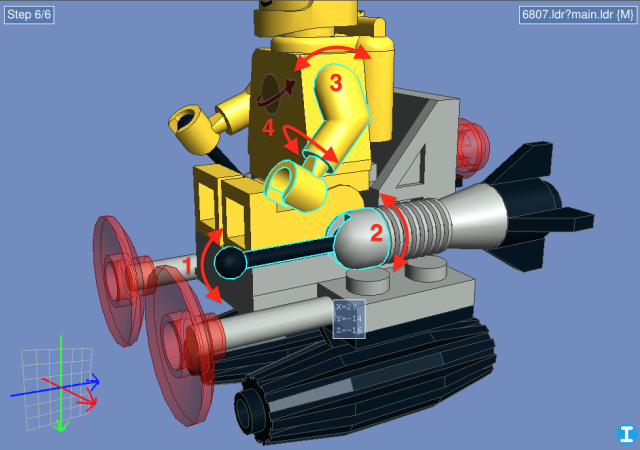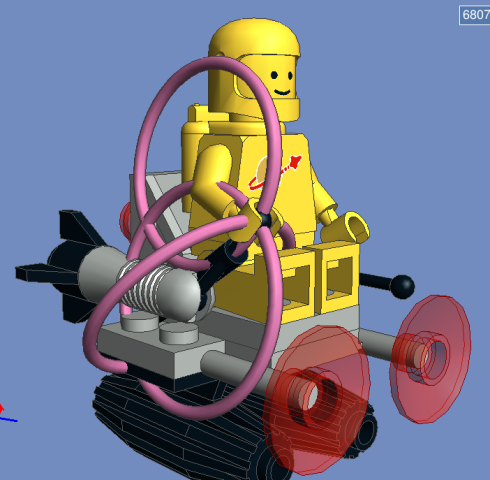This one's really just for fun; I was able to figure it out by eye to within half a degree, and I think it's good enough. But I'm still curious how you'd go about finding the "right" answer…

So our task here is simply to have our spaceman get a grip on his control stick (you can see he's already grabbed it in the right hand, so we just have to figure out the left). To do this, we need to figure out the angle of four different rotations. The control stick has to be tilted upward (1) and, along with its base, rotated inward (2), while the spaceman's arm has to pivot at the shoulder (3) to meet it. Finally, the hand has to rotate at the wrist (4) so that it's aligned with the control stick. (This last one is tricky because the hand portion—the actual "clip", or claw—is not aligned with any axis of the part itself, and the part's origin isn't located within the hand but rather at the wrist.)
Because we are perfectionists, the ball of the control stick should be centered longitudinally within the minifig's hand, but flush with its top edge. Since it's an 8-LDU sphere, the center of the sphere should be 4 LDU below the top edge (and again, that's relative to the hand itself, not the part overall).
I was able to get close on the first 3 steps (see below) by using successive approximation along with my intersecting circles method, then made some final small tweaks to account for the wrist rotation—again, good enough, but necessarily imprecise by nature. Guess I'll have to break out the trigonometry again to find the truth!

So our task here is simply to have our spaceman get a grip on his control stick (you can see he's already grabbed it in the right hand, so we just have to figure out the left). To do this, we need to figure out the angle of four different rotations. The control stick has to be tilted upward (1) and, along with its base, rotated inward (2), while the spaceman's arm has to pivot at the shoulder (3) to meet it. Finally, the hand has to rotate at the wrist (4) so that it's aligned with the control stick. (This last one is tricky because the hand portion—the actual "clip", or claw—is not aligned with any axis of the part itself, and the part's origin isn't located within the hand but rather at the wrist.)
Because we are perfectionists, the ball of the control stick should be centered longitudinally within the minifig's hand, but flush with its top edge. Since it's an 8-LDU sphere, the center of the sphere should be 4 LDU below the top edge (and again, that's relative to the hand itself, not the part overall).
I was able to get close on the first 3 steps (see below) by using successive approximation along with my intersecting circles method, then made some final small tweaks to account for the wrist rotation—again, good enough, but necessarily imprecise by nature. Guess I'll have to break out the trigonometry again to find the truth!











